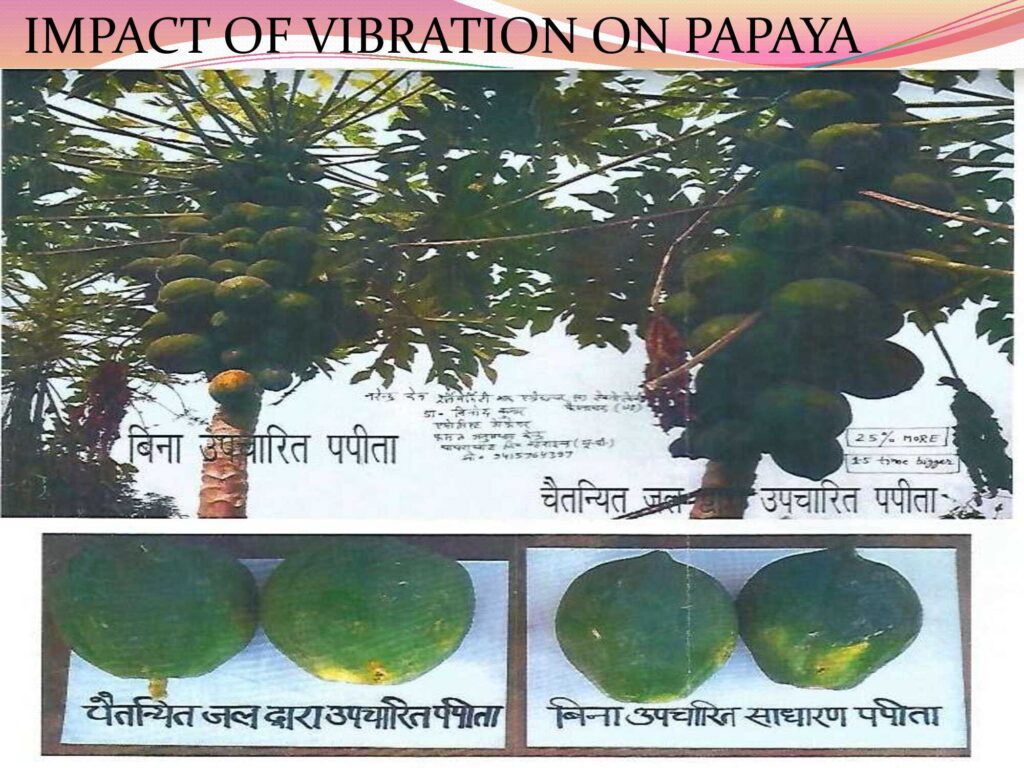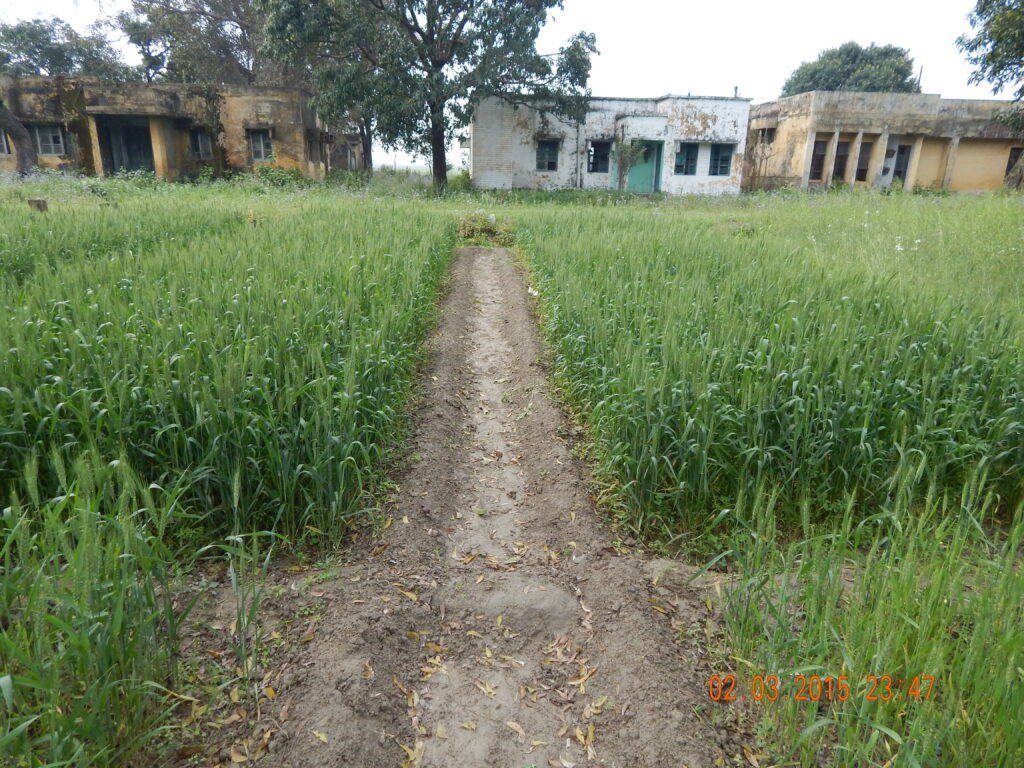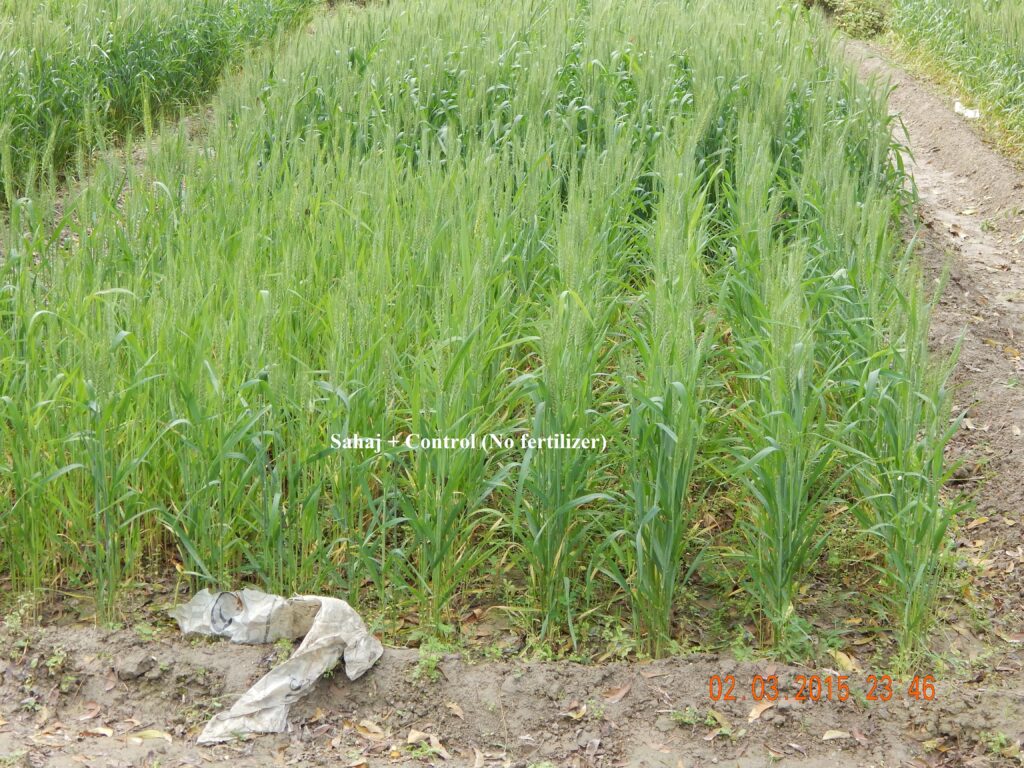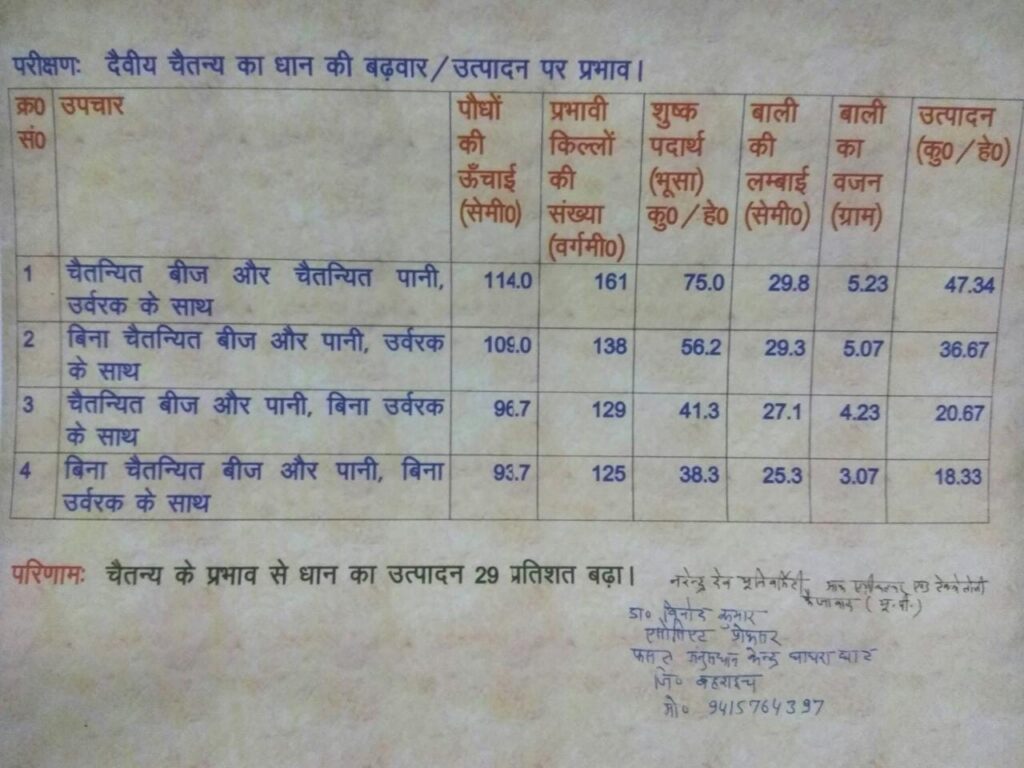Sahaj Agriculture Research Trials – N.D. University of Agriculture & Technology, Faizabad, UP
N.D. University of Agriculture & Technology, Faizabad, UP
EXPERIMENT NO.1 : EFFECT OF SAHAJA YOGA VIBRATIONS ON WHEAT PRODUCTIVITY
A field experiment was conducted by Dr. Vinod Kumar, Scientist, during rabi season of 2013-14 at Crop Research Station at Ghaghraghat, Bahraich, UP of N.D. University of Agriculture & Technology, Faizabad, to study the effect of spiritual power “Paramchaitanya” on growth and yield of wheat crop.
The soil of experimental field is sandy loam in texture having pH 8.0, low in organic carbon, available nitrogen, and phosphorus and medium in potash contents. The experiment was conducted in very small plot size 7.5 m2 (3×2.5m) in kitchen garden with four (4) treatments i.e. T1– Non- Sahaj + 75% recommended dose of fertilizer(RDF), T2– Sahaj + 75% RDF, T3– Non-Sahaj + 100% RDF, T4– Sahaj + 100% RDF replicated three times all the treatments.
Wheat seed (PBW 273) for Sahaj plots vibrated by keeping in front of H.H. Shri Mataji photograph for overnight and next morning Sahaj plots were sown with vibrated seed and non-sahaj plots with non- vibrated seed on 12th December, 2013. Vibrated water was sprinkled before sowing as well as during the crop growth in Sahaj plots.
The recommended dose of fertilizer (RDF) 120 N + 60 P2O5 + 40 K2 O kg/ha were applied as urea, di ammonium phosphate and muriate of potash. Cultural operations applied same in all the treatments of sahaj and non-sahaj plots.
The data revealed that the grain and straw yield of wheat increased with increase in fertility level from 75 to 100% recommended dose of fertilizer (RDF) of NPK alone and in combination with Sahaj yoga. Application of 75, 100% RDF of NPK in combination with sahaj yoga increased the grain and straw yield of wheat over the corresponding fertilizer doses viz., 75, 100% RDF of NPK by 11.8, 13.8 and 5.8, 7.4% respectively owing to increased availability and absorption of nutrients.
Growth and yield attribute viz., plant height and 1000-grain weight were also found higher responsible for increased grain and straw yield of wheat in above treatments. The magnitude of increase in grain yield of wheat with sahaj + 100% RDF of NPK was 43, 27.8 and 13.8% over Non-sahaj + 75% RDF, sahaj + 75% RDF and Non-sahaj + 100% RDF of NPK alone respectively. Higher harvest index was recorded with sahaj as compared to the non-sahaj treatments. The yield obtained with 75% RDF of NPK alongwith treatment of Sahaj yoga was almost same with that obtained with 100% RDF of NPK alone indicating 25% input of RDF of NPK may be saved with the treatment of Sahaj yoga.
A field experiment was conducted by Dr. Vinod Kumar, Scientist, during rabi season of 2013-14 at Crop Research Station at Ghaghraghat, Bahraich, UP of N.D. University of Agriculture & Technology, Faizabad, to study the effect of spiritual power “Paramchaitanya” on growth and yield of wheat crop.
EXPERIMENT NO.2 : EFFECT OF SAHAJA YOGA VIBRATIONS ON RICE PRODUCTIVITY
A field operation was conducted during Kharif 2012at the Crop Research Station. (M.D University of Agriculture and Technology, Faizabad, Ghaghraghat, Bharaich , UP-210901 to observe the effect of Sahaja Yoga vibrations on the growth and yield of rice crop. The soil of experimental field is sandy clay loam in texture having PH 8.2, low in organic carbon available nitrogen and medium and available potash content. The experiment was conducted in small plot size 6m2 (3m X 2m) with 4 (four) treatments.
- T1: Sahaja Yoga with fertilizer
- T2: Non- Sahaja Yoga with fertilizer
- T3: Sahaja Yoga without fertilizer
- T4: Non-Sahaja Yoga without fertilizer
All the treatments were repeated three times.
Rice seed (variety-NDR 359) of Sahaja plots vibrated by keeping in front of Shree Mataji photograph overnight till next morning. Seeds for both Sahaja and Non Sahaja plots were used for raising nursery. During nursery, we frequently gave vibrations to Sahaja plots by recalling Shree Mataji and Shree Ganesh Atharvasheesh.
21 days old and 2-3 seedlings /bulbs of 20 cms spacing of both Sahaja and Non Sahaja plots were transplanted on 22nd July 2012. The recommended dose of fertilizer of 120kg N, 60kg Po5 and 40kg K20/ha was applied as Urea Diammonium phosphate(DAP) and Mureate of potash(MOP). Cultural operations applied same in all the treatments of Sahaja and Non Sahaja. During crop growing we frequently used vibrated water and vibrations to Sahaja plots.
Table showing effect of Sahaja vibrations to rice fields and yield parameters;
| TREATMENT | PLANT HIEGHT | EFFECTIVE TILLER/m2 AT HARVEST | DRY MATTER PRODUCTION AT HARVEST (VITAL) | PANICLE LENGTH (CMS) | PANICLE WEIGHTT (%) | GRAIN YIELD (Q/HA) |
| Sahaja Yoga with fertilizer | 114 | 161 | 75 | 29.8 | 5.23 | 47.34 |
| Non Sahaja Yoga with fertilizer | 109 | 138 | 56.20 | 29.3 | 5.07 | 36.67 |
| Sahaja Yoga without fertilizer | 96.70 | 129 | 41.30 | 27.10 | 4.23 | 20.67 |
| Non Sahaja Yoga without fertilizer | 93.7 | 125 | 38.30 | 25.30 | 3.07 | 18.33 |
Mean data of three repetitions showed that the Sahaja fertilized plots (T1) gave 29% higher gain yield as compared to non Sahaja fertilized (T2) treatment. This treatment also improved growth and yield attributes viz, plant height by (4.75%), Effective tillers (16.7%), Dry matter production (33.9%) at harvest and panicle length (1.7%) and panicle weight (3.16%), in comparison to non Sahaja fertilized (T2) treatment, while in Sahaj unfertilized (T3) plots the magnitude of increase in yield (12.8%), plant height (3.2%), Effective tillers (3.2%), dry matter production (7.8%), panicle length (7.1%) and panicle weight (37.80%) were recorded as against non Sahaja unfertilized (T4) treatment.
It was also noticed that Sahaja vibrated crops looked much greener, vital and bold throughout the growing period as compared to Non Sahaja crop plants. On the basis of above results, the effect of Sahaja vibrations (ParamaChaitanya)that flow from Her Holiness Shree Mataji Nirmala Devi on rice crop is proved.
A team of All India Coordinated Rice Improvement Project, Directorate of Rice Research Hyderabad also visited this experiment and observed clear difference in growth of Sahaja and Non Sahaja crop plots and appreciated.
Experiment No.3: Effect of Sahaja vibrated water on Papaya
In my residence at crop research station, Ghaghraghat, Bahraich, there were two Papaya plants grown itself with little space in the courtyard. In which I gave vibrated water 4-5 times only to one of the plant in the beginning, whereas normal water to the other one. In Sahaja vibrated water applied plant the number of fruits were more about 25%, size of fruit 1.5 times bigger, plant more greener, vital and free from infection of mosaic disease as compared to one given normal water was recorded.
(VINOD KUMAR)
Asst. Prof Soil Sciences Crop Research Station
Ghaghraghat, Bharaich, U.P

Narendra Deva University of Agriculture & Technology (NDUAT) is a public university affiliated by ICAR. It has earned its name in giving quality education, research in the various fields of agriculture, horticulture, and training in Veterinary science, technology etc. The University has 13 affiliated colleges. Narendra Deva University of Agriculture & Technology offers UG & PG courses in multiple specializations.







